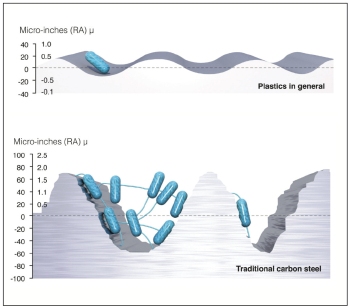Maintaining healthy pipes

Legionnaires’ Disease is an ever-present risk in many pipework systems. Des Dolan of Durapipe discusses how to help prevent legionella bacteria establishing themselves in building-services systems
Legionnaires’ Disease hit the news headlines in 2012 after a severe outbreak in Edinburgh affected over 80 people, followed by over 20 people being struck down with the disease in Stoke-on-Trent. These outbreaks caused companies up and down the country to assess their systems to ensure they are operating safely.
Legionnaires’ Disease is caused by a bacterium, legionella, that has always existed in water and remains inert at temperatures below 25°C. It proliferates in water circuits at temperatures fluctuating between 25 and 45°C — meaning sanitary-hot-water and air-conditioning circuits are most at risk from contamination.
Legionnaires’ Disease is caused by inhalation and cannot be contracted from ingestion. Infection occurs when water mists containing legionella bacteria are inhaled. These water mists can occur anywhere where water is taken from pipework systems, with showers, cooling towers, spas, high-pressure washers and humidifiers being among the most high-risk systems to spread the disease.
These pipework systems can be a major carrier of legionella bacteria within buildings, so it is crucial that steps are taken to prevent growth of this bacteria within the pipe network.
A variety of factors that can assist the potential for bacteria growth — including stagnant water, dead volumes/loops and temperatures from 25 to 45°C. Within pipework systems, the legionella bacteria develops and fixes in the presence of high concentrations of lime, magnesium, metallic residues and sludge, usually originating from corrosion and scaling. Within hot-water and air-conditioning circuits, bacteria can develop in pipework systems that are ageing, badly maintained, corroded and scaled.
While it is important that pipework systems are regularly maintained to ensure system safety, the initial product selection can also impact on the long-term health of the pipes. Our advice is that some materials are more likely to assist bacteria growth than others, so careful consideration should be given to pipework selection at the outset of a project.
Bacteria settle and develop in biofilm, which easily attaches itself to sharp or jagged parts of a pipe’s surface — whether due to the quality of the extrusion of the new pipe, or to corrosion/scale build up inside the used pipe. A rougher surface will therefore provide a stronger platform upon which to grow. This is because rough surfaces have more surface area for bacterial attachment and growth and also provide more shielding from flow.
The smoothness of the selected pipework is therefore an important factor to consider. While the surface of some metallic pipes is rough, the smooth bore of plastic pipes limits the ability for bacteria growth. While copper has natural anti-microbial properties, as limescale builds on the used, corroded pipe surface, the biofilms then cling to the limescale and begin to colonise.
Once pipework systems are installed, it is good practice to protect chilled-water and heating systems from biofilm development and the resulting bacteria growth by undertaking regular flushing and treatment processes from the outset. There are many effective methods that can be used to kill bacteria in pipework systems including flushing through systems, thermal shock and chlorine shock.
Flushing
Flushing will limit bio-film thickness in water systems; shear forces caused by flushing will remove bio-film which extends out into the turbulent flow in the centre of a pipe. Plastic pipework should always be flushed out in accordance with BS 5955 part 8.

Thermal shock
To work effectively, a temperature of 70°C must be reached and maintained throughout the entire pipework system over a period of at least 10 min, as legionella bacteria die above 60°C. This solution is the most natural and is very effective for circuits in good condition.
Chlorine shock
Another proven successful method is water disinfection. Undertake circuit chlorination by filling pipework and tanks with a chlorine mix at a concentration of 15 mg/l of cold water for 24 h or 50 mg/l for 12 h, followed by draining and thorough rinsing of all pipework. Not all pipework is suitable for chlorine shock, however. While C-PVC systems have exceptional resistance to chlorine, an ABS system would not be suitable for this method.
While preventative measures are effective, we advise that to ensure pipe safety as far as possible over the lifetime of a system, it is important to incorporate them alongside other considerations.
The correct design and pipework material is the first area that needs addressing. Once a system has been installed, it is then vital to apply preventive measures on a continuous basis and undertake regular and thorough maintenance, sampling, cleaning and treatment. Ensuring there is no water stagnation and allowing good water circulation throughout the system is then an important ongoing check.
By their very nature, plastic pipework systems can help combat bacteria growth; such materials are resistant to corrosion and limescale, resulting in a smooth bore which can limit and slow the growth process. In addition to its performance capabilities, Durapipe HTA, for example, also offers installation benefits. Its lightweight nature, combined with its quick and simple cold-weld jointing technique eliminates the need for hot works or skilled welders, further reducing the installation cost and time of projects.
The proliferation of legionella bacteria in water networks can become a major health risk, with 6000 cases of Legionnaires’ Disease diagnosed in Europe every year. The industry needs to be assessing the safety of current systems and carefully considering new specifications to ensure they offer a safe and healthy solution over the lifetime of the system.
Des Dolan is brand manager for Durapipe Building Services.








